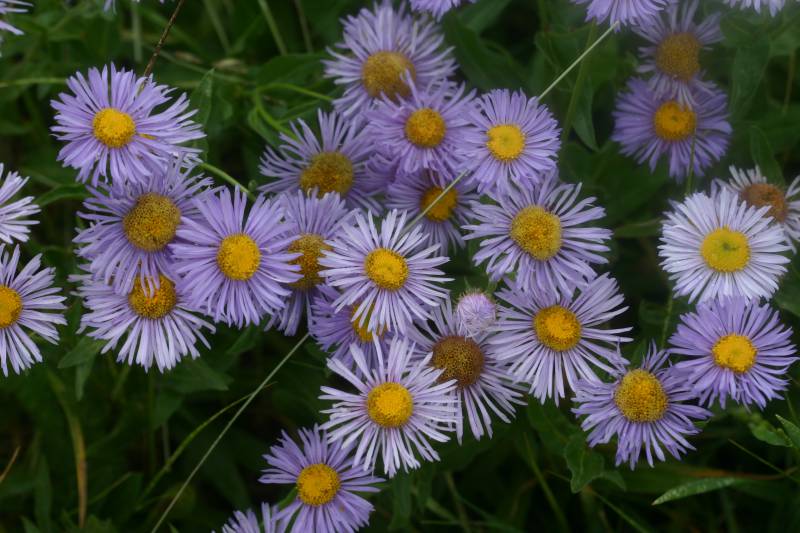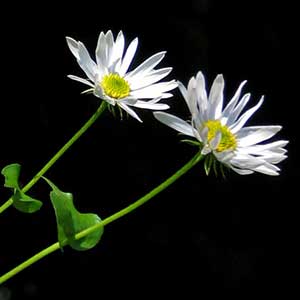|
three-veined fleabane
|
Howell's fleabane
|
| Perennial from a short, woody base, 1.5-8 dm. tall, the stems clustered, amply leafy, spreading-hairy throughout. |
Rhizomatous perennial, the stems 2-5 dm. tall, with a few woolly hairs under the heads. |
Leaves triple-nerved, entire, the lower oblanceolate or spatulate, petiolate, mostly deciduous, the other becoming sessile but ample. |
Leaves alternate, thin, glabrous, the lower ones with an ellipitical blade 2-8 cm. long and 1.5-4.5 cm. wide, abruptly contracted to the 2-12 cm. petiole; middle cauline leaves ovate to cordate, strongly clasping at the base; upper leaves similar but smaller. |
Heads 1-13 in a open inflorescence; involucre 6-9 mm. high; rays 65-150, blue or rarely white or pink, 9-18 mm. long and 1 mm. wide; pappus 20-30 bristles, a few of the outer ones shorter. |
Heads solitary; disk 12-20 mm. wide; involucre bracts loose, equal, glandular, somewhat herbaceous; rays 30-50, white, 13-25 mm. long and 2-4 mm. wide; disk corollas yellow, 4-5 mm. long, the lobes flaring; pappus simple, of 20-30 capillary bristles. |
|
Achenes asymmetrically 5-nerved. |
|
|
|
|
| July-September |
April-June |
| Moderately dry, open places at low to middle elevations. |
Moist, rocky places in the lowlands. |
Occurring on both sides of the Cascades crest in Washington; British Columbia to Washington, east to the Rocky Mountains.
|
Known only from Skamania County in Washington; Skamania County, WA to Clackamas and Multnomah counties in Oregon.
|
| Native |
Native |
| Not of concern |
Threatened in Washington (WANHP) |
E. acris, E. aliceae, E. annuus, E. aureus, E. basalticus, E. bloomeri, E. caespitosus, E. chrysopsidis, E. compositus, E. corymbosus, E. davisii, E. disparipilus, E. divergens, E. eatonii, E. elatus, E. filifolius, E. flettii, E. glacialis, E. howellii, E. inornatus, E. karvinskianus, E. leibergii, E. linearis, E. lonchophyllus, E. nivalis, E. oreganus, E. peregrinus, E. philadelphicus, E. piperianus, E. poliospermus, E. pumilus, E. salishii, E. speciosus, E. strigosus |
E. acris, E. aliceae, E. annuus, E. aureus, E. basalticus, E. bloomeri, E. caespitosus, E. chrysopsidis, E. compositus, E. corymbosus, E. davisii, E. disparipilus, E. divergens, E. eatonii, E. elatus, E. filifolius, E. flettii, E. glacialis, E. inornatus, E. karvinskianus, E. leibergii, E. linearis, E. lonchophyllus, E. nivalis, E. oreganus, E. peregrinus, E. philadelphicus, E. piperianus, E. poliospermus, E. pumilus, E. salishii, E. speciosus, E. strigosus, E. subtrinervis |
| |



